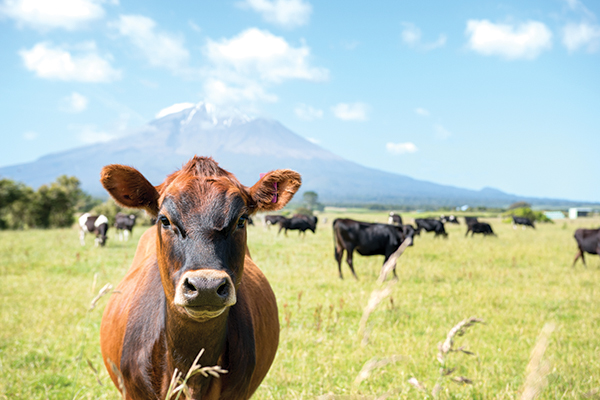A cow chewing her cud has long been an indicator of cow health. Anne Hardie reports how monitoring collars can help show how a cow’s ruminations are affected by the state of their health.
Information from cow monitoring collars shows Adam McManaway and Kirsten Daymond the changes in ruminations and activity of every cow in their 465-cow herd so they know the state of their health long before an issue is picked up by eye.
Whether it’s calving, cycling, lameness, mastitis or anything that interrupts their usual grazing pattern, it will affect rumination and activity which is revealed on the computer graphs, or in acute situations prompt a notification from the phone app.
The couple are 50:50 sharemilkers 15 minutes north of Murchison in the Top of the South and were a demonstration farm for the Allflex Livestock Intelligence collars for the first couple of years. It was a convincing experiment for them and when it finished a year ago, they invested in collars for the entire herd which was a big financial commitment for a couple who had just taken on their first sharemilking contract.
‘So in the morning I’ll go down to the cow shed after they’re milked and the cows in the left pen will be on heat and the cows in the right pen will either have mastitis or lameness. And no-one will have drafted any cows. It will have just done it itself.’
Information from the collars tells them the optimum time to inseminate each cow which means more chance of getting her in calf earlier. If a cow has a stone in her foot, it will affect her ruminations and activity which will prompt the programme to draft her off before she is obviously lame and the problem can be remedied before it worsens. And it will reveal how much each cow is producing in comparison with how much she is ruminating.

It all revolves around the time spent ruminating which is an indicator of cow wellbeing and health. It’s the process which has the cow regurgitating previously eaten food and masticates it a second time – chewing their cud. A cow will typically ruminate eight to nine hours a day and a drop in the amount of time she ruminates indicates something is happening. A big change means it’s something quite crucial which is why a cow chewing her cud has long been an indicator of cow health. It’s a lot clearer on a graph though which shows just how much those ruminations are changing and when.
An increasing number of herds in the country are now using collars or similar technology to gather information and Adam and Kirsten say it is the way of the future for dairy farming. Their system has recently been upgraded with improved algorithms and they will have the ability to upgrade.
The couple have farmed as far south as Whataroa in South Westland and north to the plains around Lake Wairarapa before arriving at Murchison for a manager’s job initially on Dave and Jane Field’s farm who had moved to Tasmania for a larger dairying enterprise. Dave and Jane gave them the opportunity to start buying cows and leasing them back, which enabled them to build up enough equity to take on the 50:50 sharemilking job last year. Adam says they have been lucky to have supportive farm owners who helped them into their 50:50 sharemilking contract and allowed them to be a demonstration farm for the collars.
At Murchison, they farm both sides of the highway where up to 7,000 cars pass through each day in the middle of summer and an underpass connects the farming operation. On 135 effective hectares they milk 465 crossbred cows with a target this season of 215,000kg milksolids (MS) and 475kg MS/cow. Their top production so far has been 214,000kg MS and they aim to stay within the top 10% for milk production in the Tasman region.

Cows are milked twice a day through to March, when they drop to three-in-two milkings and then once-a-day for the last month to dry off – all depending on the season and supplements. They operate a system three on the DairyNZ production system, with 300 tonnes of palm kernel – PK20 which has molasses as well – added to the 500 bales of balage made on the 75ha support block they lease nearby. It grazes the young stock and winters the cows as well. On the milking platform, K-line irrigation waters 120ha from the Buller River which borders one side of the long, narrow farm.
The collars will read up to 800 metres from the shed and sometimes stretch out to a kilometre, but even when they are out of range, they still collect information and that is downloaded when they get within range on their way to the dairy for milking.
“As long as the drafting gate gets that information while they’re being milked it will draft them in the different directions they need to go,” Adam explains. “At the moment, (beginning November) we draft cows on heat one way and cows with health issues the other way. It will detect all those problems itself and it will draft on its own. So in the morning I’ll go down to the cow shed after they’re milked and the cows in the left pen will be on heat and the cows in the right pen will either have mastitis or lameness. And no-one will have drafted any cows. It will have just done it itself. It’s quite impressive.”
An antenna on the roof of the house enables internet to be sent down to an antenna on the workshop roof beside the dairy, with a few wifi boosters around to get as much coverage as possible. A barcode on the collar is in the system and her information is downloaded when she is within range into their Heatime Pro system, and if needed, automatically drafted into a separate mob.
Looking at a cow’s graph, it shows a substantial change in ruminations and activity at calving, then the effect of recovering from calving in the colostrum herd, the change to the main herd, the first cycle and then the second cycle in time to capture the optimum time to inseminate her.
“If we’d relied on tail paint to inseminate her, we may have missed the crucial time, wasted $28 on insemination and she wouldn’t be in calf. When a cow is on heat, she will have 90% more activity on the day she is cycling than any other day of the month and her rumination drops 30%. It’s just about identical with every single cow. So she will ruminate significantly less and walk significantly more around the paddock.
“All this is, is a better tool to be more accurate to draft the correct cow to be inseminated and it increases your conception rate because the cows you are inseminating are actually at that optimum ovulation time to conceive. I’ll look through the list every morning on the computer and if it says there’s 19 cows on heat, I’ll look at all their graphs to make sure it’s close to 100% (heat index rating) and it will tell you when her last cycle was.”
During the demonstration period they also used collars on the carryover cows which are run on 30ha of rough hills at the back of the milking platform. Adam says they never brought the cows down off the hills and never put tail paint on them, yet the collars recorded when they cycled and when they got in calf.
“We had no human interaction with the cows, yet we knew every single thing that they were doing every day.”
The cost of the collars is offset by getting cows in calf and reducing health-related problems that reduce the cow’s time in the milking herd, but also through less staff in the dairy through mating. Before they invested in the collars, Adam says they would have had two people in the dairy for six to eight weeks through mating, checking tail paint and manually drafting them, which cost between $100 and $150 per day. Plus, the computer is doing a better job.
“So when you spread the costs over the life span of a cow, it more than pays for itself. And we should be able to stretch the life of a cow out a bit longer because we’re going to have more chance of keeping her in calf. And if she has any health issues, you’re on top of it before even mating time starts and have her in good healthy condition to be able to get in calf.”
Such as lameness, which still occurs, but because they are on to it earlier, there’s less damage and no infection, so no need for antibiotics and the cows is back with the herd.
Or at calving, when a problem after calving is getting pretty serious by the time an infection occurs and becomes obvious – or a second calf hasn’t been delivered, so catching it early saves money and maintains production.
At calving it also sends out the text alert when a cow is calving and even though they are checking the herd regularly, it’s alerting them when they are not in the paddock.
When culling, Adam looks at the information for every cow to see how much she is ruminating and then looks at the herd test result to see how much she is actually producing. It’s clear which are the most efficient cows.
“You’ll find a lot of them eat just as much, produce bugger all and you will pick it upon the herd test, but you won’t realise how much they’re ruminating because the herd test won’t tell you that.”
Adam says scales could be added at the exit race to record cow weight and the system could be linked to milk meters to show how much milk each cow is producing at each milking. That would add weight to the data recorded, alongside rumination and activity. As sharemilkers, he says that is not an option as it would mean spending money to upgrade the dairy.
You don’t have to be a whizz on the computer to use the collars and interpret the information and he says that if you can send a text message, you can probably figure it out.
“As long as you’re willing to put the data into the system it will work for you. But if you are one of those people what struggle with putting data into Minda, then it’s not the system for you.
Farmers also need to be willing to be educated, Kirsten adds, and scares such as Mycoplasma bovis have shown the benefits of technology and recording.

Kirsten works a couple of shifts as a nurse in nearby Murchison which enables flexibility around two-year-old Patrick. She’s been lucky to find a job as a nurse in a small community where jobs are scarce. When they arrived in Murchison, she spent 12 hours a week driving back and forth to Nelson for work but the arrival of Paddy meant that couldn’t go on.
Finding staff for the farm is also a challenge in a small community. Through calving, there was just Adam and full-time staffer Lorraine Miller which stretched them both.
It’s isolated as a community, but has thousands of people driving through the middle of the farm every day and Adam says they let them know when they think something is wrong.
“Especially at calving time you’ll get a couple of people every day coming in and saying you’ve got a dead cow down there. And we’ll say, well actually she’s calving – we’ve just been down to check two minutes ago.”
Plus, with the collars, they know exactly what each cow is doing as well as her health, whether they are in the paddock or not.
Farm facts
Farm owners: Dave and Jane Field
Sharemilkers: Adam and Kirsten McManaway
Location: Murchison, Top of the South
Milking platform: 135ha
Herd: 465 crossbred cows
Production: 475kg MS/cow on system 2/3
Technology: SCR Allflex collars for rumination and activity





